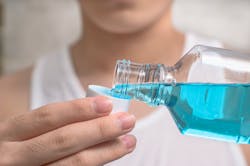Chlorhexidine mouthwash: Still the best choice for dental patients?
Prior to any dental treatment, patients may be asked to swish with an antibacterial rinse (ABR). Dental professionals might dispense one ounce or 20 mL and ask patients to swish for 60 seconds to kill germs, and then spit out the rinse. Daily ABRs have long been recognized as beneficial in killing oral microbes.1,2 The oral cavity is estimated to contain about six billion bacteria, representing 700 different species.3 By using a preprocedural ABR, clinicians are trying to reduce the oral bacterial load and thus decrease the risk of transmission from aerosols.1-7
Chlorhexidine mouthwash (CHX) is one of the many ABRs available for dental patients. For years, CHX was considered the “top dog” of therapeutic mouth rinses. When it was first marketed in 1970, CHX could only be prescribed to patients by a doctor or dentist.4 Dental professionals liked CHX rinse because it helped with plaque control, gingivitis, and even healing slight traumatic lesions such as oral ulcerations.5 Due to its germ-killing properties, CHX rinse became the go-to for patients to use at the start of their dental appointments. It soon began to be marketed in various forms of application for dental use.6 Today, CHX can be found in antimicrobial mouthwash, oral gels, and chips. A “chip” is a biodegradable insert that is soaked in 2.5 mg of CHX digluconate and then placed inside the periodontal pocket.6
You may also be interested in … Chlorhexidine: The good, the bad, and the ugly
How does chlorhexidine work?
CHX works by binding with the bacterial cell membrane, causing a disruption in the cell makeup.2,6 This makes CHX bactericidal and bacteriostatic.1 CHX does not have the same effect on oral fungi and viruses as it does on oral bacteria.6
What are the negative effects of CHX?
While CHX rinse does kill oral microbes, it can also have negative effects on the oral cavity in the form of teeth staining, heavy calculus accumulation, altered tastebuds, low patient compliance, tissue irritation, potential carcinogenicity, flammability, possible allergic reactions, and more.7 Teeth staining, heavy calculus growth, and altered taste tend to be the most common complaints patients report from using CHX rinse.7 However, some patients don’t like CHX rinse because they are instructed to wait at least 30 minutes after swishing to brush their teeth, since sodium lauryl sulfate will deactivate the CHX.2 Patients must also wait 30 minutes before eating or drinking after swishing with CHX rinse. These limitations may reduce patient compliance.2
More on chlorhexidine … CHX-treated air filters tested in trains found to kill SARS-CoV-2 and other microbes
What does science say about CHX?
While patients and dental professionals are noticing side effects when using CHX, science is questioning whether CHX should still be the gold standard for ABRs. Recent studies have shown that the risks of using CHX may outweigh the benefits, and that newer ABRs coming on the market may be just as effective—or even more effective—at helping patients achieve a healthier mouth and protecting dental professionals from aerosols.2,4-7
One study looked at the effects of CHX mouth rinse in healthy individuals. This single-blind, crossover, nonrandomized study had healthy patients rinse with CHX for seven days. The interesting part about this study is that most of the time CHX rinse is given to patients with unhealthy mouths. Very little research has been done on what would happen if 2 mL of CHX rinse were added for one week to a mouth with good microbial levels.
Over the course of the study, it was concluded that CHX had a negative effect on healthy mouths because it made the salivary composition more acidic with higher glucose levels.4 This made the oral cavity more susceptible to caries than it otherwise would be.4
Another study investigated the effectiveness of CHX as an ABR for patients. This review found that there was conflicting evidence about CHX’s effectiveness in killing the microbial load.6 Not only did the narrative point out that CHX killed bacteria differently than it killed other microbes, such as viruses and fungi, but it also took much longer to work effectively than it was once thought; thus, it would not be sufficient to act as a preprocedural rinse. This review suggested that CHX rinse be studied in further detail to better conclude its effectiveness.6
More on chlorhexidine … The need for objective, evidence-based efficacy testing of oral rinses
How do health-care professionals feel about CHX?
Some dental professionals argue that the math doesn’t add up to recommend CHX. CHX cannot be used for a long period of time due to its known side effects. Most medical professionals only recommend that patients use CHX rinse for two weeks.7 Since most tissues take longer than two weeks to heal, and because the oral bacteria will still be accruing long after the 14-day period, it doesn’t make sense to recommend CHX rinse.7
Other commonly used ABRs have been shown to be as effective as CHX when it comes to protecting clinicians from aerosols inside the dental operatory. Both cetylpyridinium chloride (CPC) and chlorine dioxide (ClO2) mouth rinses are effective at reducing dental operatory aerosols, but they don’t have the same side effects or concerns as CHX.1
How should chlorhexidine be used in dentistry today?
Dental professionals need to recognize the benefits and risks of using CHX as a recommendation for treatment and as a preprocedural mouth rinse. What was once considered the best ABR to recommend to patients may no longer be the case. Reviewing each patient’s needs and medical history will guide the clinician’s decision to prescribe (or not to prescribe) CHX.
It may be wise for the dental professional to prescribe CHX for the patient while reviewing the potential for side effects. If the patient’s needs are not met with the CHX regimen, the dental professional may recommend that the patient return in two weeks to determine the next course of action.
Dental teams need to reconsider their use of CHX in the dental office, since other ABRs may be more readily available and better at killing microbes instantly. Further research is needed.
Editor’s note: This article first appeared in Through the Loupes newsletter, a publication of the Endeavor Business Media Dental Group. Read more articles and subscribe to Through the Loupes.
References
- Bravo-Nguyen R. Reduce aerosol risk with preprocedural mouthrinse. Dimensions of Dental Hygiene. November 24, 2020. https://dimensionsofdentalhygiene.com/article/reduce-aerosol-risk-preprocedural-mouthrinse/
- Bowen DM, Pieren JA. Darby and Walsh Dental Hygiene Theory and Practice. 5th ed. Elsevier; 2020.
- How KY, Song KP, Chan KG. Porphyromonas gingivalis: an overview of periodontopathic pathogen below the gum line. Front Microbiol. 2016;7:53. doi:10.3389/fmicb.2016.00053
- Bescos R, Ashworth A, Cutler C, et al. Effects of chlorhexidine mouthwash on the oral microbiome. Sci Rep. 2020;10(1):5254. doi:10.1038/s41598-020-61912-4
- Bradley N. What are the different roles for chlorhexidine mouth rinse in dentistry? Colgate. April 2021. https://www.colgateprofessional.com/dentist-resources/patient-care/what-are-the-different-roles-for-chlorhexidine-mouth-rinse-in-dentistry
- Brookes ZLS, Bescos R, Belfield LA, Ali K, Roberts A. Current uses of chlorhexidine for management of oral disease: a narrative review. J Dent. 2020;103:103497. doi:10.1016/j.jdent.2020.103497
- Martino R. Revealing the truth about chlorhexidine, and a better alternative. Decisions in Dentistry. June 28, 2022. https://decisionsindentistry.com/article/revealing-the-truth-about-chlorhexidine-and-a-better-alternative/
About the Author
Tracee S. Dahm, MS, BSDH, RDH
Tracee S. Dahm, MS, BSDH, RDH, is an adjunct clinical instructor for the North Idaho College School of Dental Hygiene in Coeur d’Alene, Idaho, and she also works in private practice. She has been published in several dental journals, magazines, webinars, and textbooks. Tracee is a key opinion leader on cutting-edge innovations in the hygiene field. Her research interests include trends in dental hygiene, improving access to dental care for the underserved, and mental health. Contact her at [email protected].

